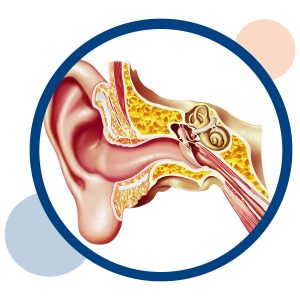Eustachian Tubes
 Eustachian Tube Dysfunction
Eustachian Tube Dysfunction
Causes and Treatments
Eustachian tube dysfunction (ETD) and related inner ear problems affect seven out of ten children before they reach age 7. It often requires some medical intervention. If you want to know how to treat eustachian tube dysfunction, your Pediatric ENT doctor is ready to help.
The good news is that surgery is not the first line of defense. Antibiotics and decongestants may be all a child needs to get well. To protect a child’s hearing, however, it is important to see an ear, nose and throat specialist if your child has inner ear problems.
What is the Eustachian Tube Dysfunction?
Eustachian tube dysfunction is when the tube does not open properly, preventing air from entering the middle ear. Eustachian tube dysfunction causes increased air pressure on the outer side of the eardrum which pushes the eardrum inward. This pressure causes
What is the Eustachian Tube?
The eustachian tube is a narrow tube that connects the middle ear to the back of the nose and throat. This narrow passageway controls pressure on the eardrum. Normally closed, the tube opens when a person swallows or yawns.
Why are Children so Vulnerable to Eustachian Tube Dysfunction?
Children’s anatomy is different than an adult’s. Plus they have fewer immunities. This combination causes them to be more susceptible to ETD and ear infections.
In children, their natural tubes are smaller. The tubes are horizontal rather than slanted. Without gravity to help direct it, fluid is more likely to get stuck inside the tube. In some cases, a child’s adenoids may be too big, blocking the tube’s opening. A child is prone to fluid buildup when they have a cold, allergy-related nasal congestion, respiratory illness or sinus infection.
ETD Symptoms and Dangers
Parents should watch for these symptoms:
- Babies may pull at their ears
- Children may express that their ears feel full
- They may complain about ringing or popping noises in the ears
- Parents may notice a speech delay or hearing problems
- Some children may experience dizziness.
ETD Diagnosis and Treatment
Children should find nothing scary about ETD diagnosis. The doctor uses an otoscope which lights the ear canal. The child’s adenoids and throat will also be examined. Any history of ear infections will be discussed. A combination of medicines may be suggested or prescribed, depending on the child’s age.
If medicine doesn’t handle the problem or if ear infections occur too often, then the doctor will want to discuss how tubes or adenoid surgery may benefit your child.
Pediatric ENT of Oklahoma is here to provide
